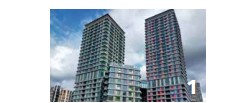'Hybrid' precast concrete is the term used to refer to concrete products that are partially precast offsite in a factory and then completed with 'in-situ' concrete on-site.
For leading supplier Kerkstoel, the two most widely used products are Twin Walls and Wide Slabs – also known as lattice or filigree slabs. Whilst they have been widely used in mainland Europe for many years, these products remain relatively unknown and under-used in the UK.
Wide Slabs Consisting of a thin shell – normally 60mm of factory-cast concrete containing the lower layer of reinforcement plus lattice reinforcement – which gives the element rigidity during lifting and on-site casting and acts as support for the top layer of reinforcement which is placed on-site before the upper layer of concrete is poured.
Wide slabs can also incorporate pipework to create 'activated' flooring, allowing warming or cooling of the building taking advantage of the thermal mass of the concrete. This is one of the most energy efficient methods of doing this.
Twin Walls Essentially, two wide slabs connected by the lattice reinforcement with a gap of 60mm or more between the skins, which is filled with concrete on-site. The precast skins contain all the reinforcement.
The twin walls can also incorporate an insulation layer if required. All the products are custom made to the customer's requirements and can incorporate openings for doors, windows and electrical boxes, ducting etc. Structurally they are practically the same as cast in-situ concrete with extremely rapid on-site construction where a team of three can typically install 200sq m of walls or 400sq m of slabs per day.
With high quality and accuracy due to factory production plus little waste, they are lighter than solid precast panels for craneage and transport and with just in time delivery – little or no on-site storage space required.
Read the full article, go to Offsite Magazine









